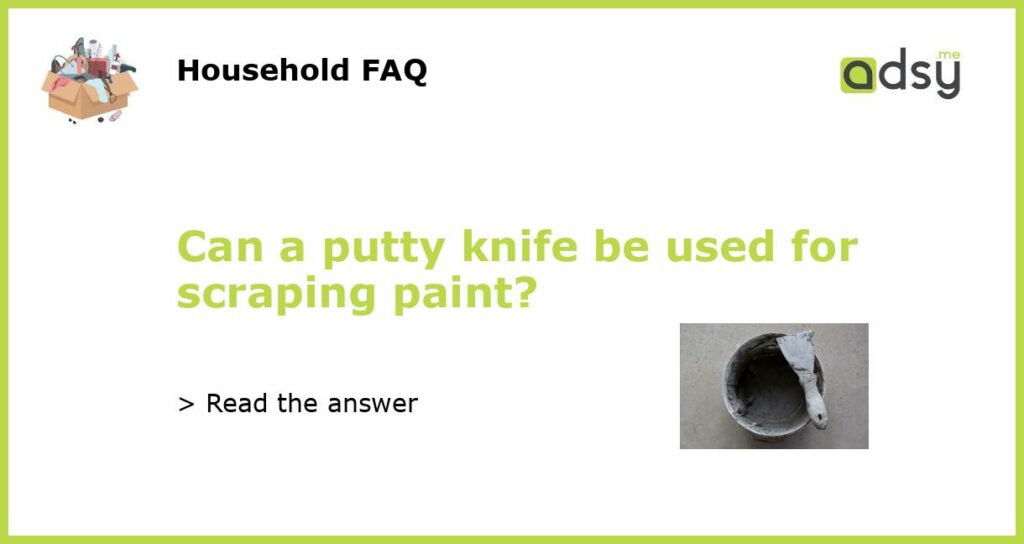Yes, a Putty Knife Can Be Used for Scraping Paint
If you’re planning on repainting a wall, furniture, or any other surface, one of the most important steps is preparing the surface by removing old paint. A common tool used for this task is a putty knife. Putty knives are typically used for scraping old paint, filling cracks, and applying putty or spackle. While they may not be the most traditional choice for scraping paint, they can be a versatile tool that gets the job done.
The Benefits of Using a Putty Knife for Scraping Paint
There are several benefits to using a putty knife for scraping paint:
1. Versatility: Putty knives come in various sizes and shapes, making them adaptable to different surfaces and angles. This versatility allows you to maneuver the tool into tight corners, edges, and other hard-to-reach areas that might be difficult to access with a traditional paint scraper.
2. Flexibility: Putty knives are made from flexible metal blades, typically stainless steel. This flexibility allows the blade to conform to the surface being scraped, ensuring maximum contact and efficiency when removing paint. It also reduces the risk of damaging the underlying material.
3. Control: Due to their thin blade and handle design, putty knives offer excellent control. This control allows you to apply the right amount of pressure while scraping, preventing accidental gouging or scratching of the surface. It also helps you maintain a steady scraping motion, ensuring consistent results.
Steps to Safely Remove Paint Using a Putty Knife
While a putty knife can be an effective tool for scraping paint, it’s important to use it properly to avoid any damage. Here are some steps to follow:
1. Prepare the area: Before starting, ensure the area is well-ventilated and covered with drop cloths. Remove any furniture or objects that could get in the way or be damaged during the process.
2. Inspect the surface: Carefully examine the surface you’re planning to scrape. Look for any cracks, loose paint, or areas that need extra attention. If there are any areas with loose or peeling paint, gently scrape them first to create a smooth surface.
3. Choose the right putty knife: Select a putty knife with a blade size appropriate for the surface you’re working on. Larger blades are better for large, flat areas, while smaller blades are more suitable for tight corners and edges.
4. Scrape at a shallow angle: Hold the putty knife at a shallow angle, around 30 degrees, and start scraping from one edge of the painted surface. Apply smooth, even pressure as you move the knife back and forth. Be careful not to dig or gouge the surface.
5. Remove paint residue: As you scrape, periodically wipe off the paint residue from the putty knife using a rag or paper towel. This helps prevent the paint from smearing and makes it easier to see any missed spots or areas that need additional scraping.
6. Repeat if necessary: Depending on the thickness and type of paint, you may need to repeat the scraping process several times to remove all the layers. Take breaks if needed and stay patient to achieve the best results.
Alternatives to Using a Putty Knife for Scraping Paint
While a putty knife can be a useful tool for scraping paint, there are alternatives available:
1. Paint scraper: Traditional paint scrapers have a thicker blade and a handle specifically designed for paint removal. They may provide more leverage and strength than a putty knife, making them suitable for large areas or tougher paint.
2. Heat gun: If you’re dealing with multiple layers of paint or particularly stubborn paint, a heat gun can be a helpful tool. The heat helps soften the paint, making it easier to scrape off. However, caution must be taken to avoid damaging the surface or starting a fire.
3. Chemical paint strippers: Chemical paint strippers are an option when dealing with thick or multiple layers of paint. Apply the stripper according to the manufacturer’s instructions, and then use a paint scraper or putty knife to remove the softened paint.
4. Sandpaper: For small areas or delicate surfaces, sandpaper can be used to gently remove paint. Use a fine-grit sandpaper and work in a circular or back-and-forth motion to avoid scratching the surface.
5. Electric sander: For larger projects or extensive paint removal, an electric sander can save time and effort. Choose a sander with an appropriate grit and use it carefully to avoid damaging the surface.
In conclusion, yes, a putty knife can be an effective tool for scraping paint. Its versatility, flexibility, and control make it a popular choice for DIY paint removal projects. However, it’s important to follow the proper steps and technique to avoid any damage to the surface. If you’re unsure or dealing with a challenging paint removal project, consult a professional or consider alternative tools like paint scrapers, heat guns, chemical paint strippers, sandpaper, or electric sanders.






